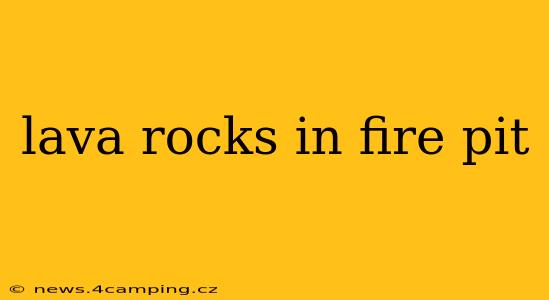Lava rocks, with their rugged beauty and heat-resistant properties, are a popular choice for fire pit fillers. But are they the right choice for your fire pit? This comprehensive guide dives into the pros, cons, and everything you need to know about using lava rocks in your fire pit, ensuring you make an informed decision.
Why Use Lava Rocks in a Fire Pit?
Lava rocks, also known as volcanic rocks, offer several advantages:
- Heat Resistance: Their natural composition allows them to withstand extremely high temperatures without cracking or breaking, making them ideal for fire pits.
- Aesthetics: They provide a rustic, natural look that complements various outdoor settings, from modern to traditional. The dark, earthy tones add a touch of elegance to any fire pit.
- Accessibility and Affordability: Lava rocks are readily available at most home improvement stores and landscaping suppliers, making them a budget-friendly option.
- Good Heat Retention: While they don't retain heat as well as some other materials, they do help distribute the heat more evenly across the fire pit.
Are Lava Rocks Safe for Fire Pits?
While generally safe, there are a few safety considerations:
- Potential for Cracking: Although highly heat-resistant, extremely rapid temperature changes (e.g., pouring water on hot rocks) can cause them to crack. Always allow the rocks to cool down naturally before adding water.
- Sharp Edges: Some lava rocks have sharp edges, which can pose a tripping hazard. Carefully select rocks with smoother surfaces or handle them with caution.
- Harmful Fumes (Rare): In extremely rare cases, certain types of volcanic rock may release harmful fumes when exposed to high heat. However, this is uncommon with commercially available lava rocks intended for fire pits.
What are the Alternatives to Lava Rocks?
Several alternatives offer different aesthetic and functional benefits:
- River Rocks: Smoother than lava rocks, offering a more polished look. However, they may not withstand extreme heat as well.
- Glass Fire Gems: These come in vibrant colors and offer a more modern aesthetic, but they can be more expensive.
- Ceramic Fire Beads: These are highly heat-resistant and come in various colors, but might be a pricier option.
- Sand: A budget-friendly option, but it requires more frequent replenishment due to shifting.
How Much Lava Rock Do I Need for My Fire Pit?
The amount of lava rock needed depends on the size and depth of your fire pit. A general rule of thumb is to fill the pit to a depth of about 4-6 inches. Measure the volume of your fire pit (length x width x depth) and consult your supplier for specific quantity recommendations.
How Do I Clean Lava Rocks in My Fire Pit?
Cleaning lava rocks is generally straightforward. Once the rocks have completely cooled, use a stiff brush or broom to remove ash and debris. For stubborn stains, you can use a hose to rinse them. Avoid using harsh chemicals.
Can I Use Lava Rocks From My Yard in My Fire Pit?
Using lava rocks from your yard is not recommended unless you are certain they are indeed volcanic rock and can withstand high temperatures. Untested rocks may crack or release harmful substances when heated. Always opt for commercially sourced lava rocks designed for fire pits.
How Long Do Lava Rocks Last in a Fire Pit?
With proper care, lava rocks can last for many years. However, the rate of wear and tear depends on the frequency of use, the intensity of the heat, and the type of fuel used.
Conclusion: Making the Right Choice
Lava rocks offer a compelling blend of aesthetics, functionality, and affordability for fire pit fillers. By understanding their advantages, safety concerns, and maintenance requirements, you can confidently decide if they're the right fit for your outdoor space. Remember to prioritize safety and always choose high-quality lava rocks specifically designed for fire pit use.
